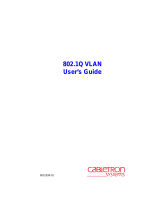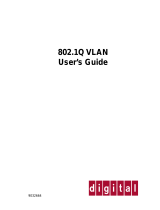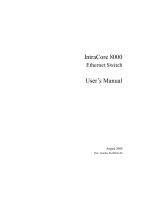
iv Contents
3.4.1 Defining a VLAN ........................................................................... 3-10
3.4.2 Changing the VLAN to FID Association ........................................ 3-11
3.4.3 Renaming a VLAN ........................................................................ 3-11
3.4.4 Deleting a VLAN ........................................................................... 3-12
3.4.5 Enabling VLANs............................................................................ 3-12
3.4.6 Disabling VLANs ........................................................................... 3-12
3.4.7 Changing the Forwarding Mode.................................................... 3-13
3.4.8 Paging Through the VLAN List ..................................................... 3-13
3.5 Port Assignment Configuration Screen ......................................................... 3-14
3.5.1 Changing the Port Mode ............................................................... 3-15
3.5.2 Assigning a VLAN ID .................................................................... 3-16
3.5.3 Paging Through the Port List ........................................................ 3-17
3.6 Port Filtering Configuration Screen ............................................................... 3-17
3.6.1 Displaying VLAN IDs Associated with a Port ................................ 3-19
3.6.2 Selecting the Type of Filtering for a Port....................................... 3-20
3.7 VLAN Forwarding Configuration Screen ....................................................... 3-20
3.7.1 Viewing Current VLAN Ports......................................................... 3-22
3.7.2 Paging Through VLAN Forwarding List Entries ............................ 3-22
3.7.3 Adding Forwarding List Entries ..................................................... 3-22
3.7.4 Deleting Forwarding List Entries ................................................... 3-23
3.7.5 Changing the Frame Format......................................................... 3-23
3.8 Protocol VLAN Configuration Screen............................................................ 3-24
3.8.1 Displaying the Current Protocol, VLAN ID, and
Port Assignments.......................................................................... 3-27
3.8.2 Assigning a Protocol Family to a VLAN ID.................................... 3-27
3.8.3 Displaying the Protocol Types on Current Ports ........................... 3-29
3.9 Protocol Ports Configuration Screen............................................................. 3-29
3.9.1 Adding/Deleting Ports Associated with a VLAN ID ....................... 3-31
3.10 Quick VLAN Walkthrough ............................................................................. 3-32
4
4.1 Example 1, Single Switch Operation............................................................... 4-1
4.1.1 Solving the Problem........................................................................ 4-2
4.1.2 Frame Handling .............................................................................. 4-3
4.2 Example 2, VLANs Across Multiple Switches ................................................. 4-3
4.2.1 Solving the Problem........................................................................ 4-4
4.2.2 Frame Handling .............................................................................. 4-6
4.3 Example 3, 1D Trunk Connection to 802.1Q VLAN Network.......................... 4-8
4.3.1 Solving the Problem...................................................................... 4-10
4.3.2 Frame Handling ............................................................................ 4-11
4.4 Example 4, Isolating Network Traffic According to Protocol ......................... 4-14
4.4.1 Solving the Problem...................................................................... 4-15

























